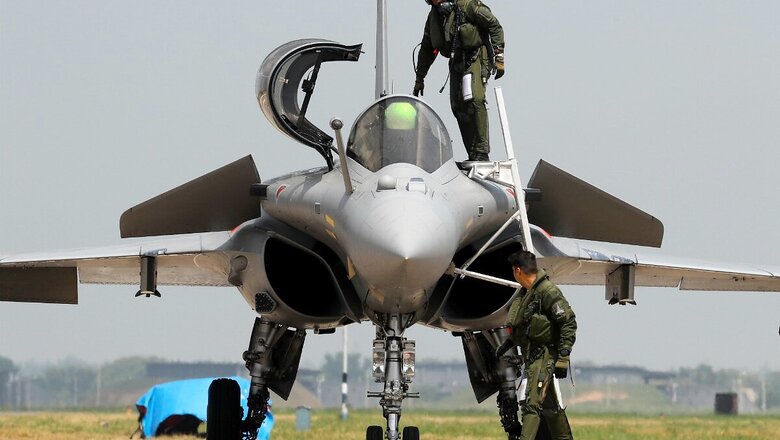
views
The first batch of five Rafale fighter jets were formally inducted into the Indian Air Force on Thursday at Ambala air base, in the presence of Defence Minister Rajnath Singh, his French counterpart Florence Parly and Air Chief Marshal RKS Bhadauria.
Singh used the ceremony send a strong message to China over its belligerence in eastern Ladakh, saying national security is a major priority for India and it is determined to protect its territory. Singh said induction of Rafale jets into the IAF is crucial considering the kind of atmosphere being created along India’s border.
“It is a strong message for the entire world, especially those eyeing India’s sovereignty,” he said in an address at a ceremony in Ambala marking formal induction of the Rafale fleet. Singh’s stern message to the neighbouring country came hours ahead of an expected meeting between External Affairs Minister S Jaishankar and his Chinese counterpart Wang Yi on the margins of a Shanghai Cooperation Organisation (SCO) conclave in Moscow.
The much anticipated talks are taking place against the backdrop of a massive spike in tension in eastern Ladakh triggered by fresh face-offs between the two armies along the Line of Actual Control (LAC). The defence minister said India’s responsibility is not limited to its territorial boundary and that it is committed to peace and security in Indo-Pacific and Indian Ocean, the two regions where China has been increasing its military assertiveness.
“This kind of induction is very important for the kind of atmosphere that has been created on our borders in recent times,” the defence minister said in a clear reference to the escalating tensions in eastern Ladakh. The defence minister also complimented the IAF for its “swift action” near the Line of Actual Control (LAC) during a “recent unfortunate incident”. He, however, did not elaborate on it.
“The speed at which IAF deployed assets on forward bases creates confidence,” he said. “While prevailing situation on our border caught our attention, we should not ignore threat of terrorism,” he added.
Speaking on the occasion, Air Chief Marshal RKS Bhadauria said induction of Rafale jets could not have happened at a more opportune time considering the security scenario. The Indian Army on Tuesday said Chinese troops attempted to close in on an Indian position near the southern bank of Pangong lake on the evening of September 7 and fired shots in the air.
The Army said this in a statement after the PLA late on Monday night alleged that Indian troops crossed the LAC and “outrageously fired” warning shots near the Pangong lake. A meeting between Defence Minister Singh and his Chinese counterpart Gen. Wei Fenghe on the margins of another SCO meet in Moscow last Friday apparently did not yield any tangible outcome.
The Rafale jets landed at the Ambala Air Force base at around 3:10 pm on July 29 after covering a distance of 7,000 km from the Merignac airbase in French port city of Bordeaux. The jets were also refuelled mid-air from a French tanker at a height of 30,000 feet, according to the Indian Embassy in France.
The first Rafale jet was handed over to the IAF in October last year during a visit to France by the defence minister. While the first squadron of the Rafale jets will be stationed at Ambala airbase, the second one will based at Hasimara base in West Bengal.
The Ambala base is considered one of the most strategically located bases of the IAF as the Indo-Pak border is around 220 km from it. Authorities had imposed prohibitory orders near the Ambala Air Force Station and banned taking of pictures and videos. A large number of police personnel were also deployed in a three-kilometre radius. The IAF has spent around Rs 400 crore to develop required infrastructure like shelters, hangars and maintenance facilities at the two bases.
Out of 36 Rafale jets, 30 will be fighter jets and six will be trainers. The trainer jets will be twin-seater and they will have almost all the features of the fighter jets. India began the process to buy a fleet of 126 Medium Multi-Role Combat Aircraft (MMRCA) in 2007 after the defence ministry, headed then by AK Antony, cleared the proposal from the IAF.
The contenders for the mega deal were Lockheed Martin’s F-16s, Eurofighter Typhoon, Russia’s MiG-35, Sweden’s Gripen, Boeing’s F/A-18s and Dassault Aviation’s Rafale.
After a long-drawn process, bids were opened in December 2012 and Dassault Aviation emerged as L-1 (lowest bidder). In the original proposal, 18 planes were to be manufactured in France and 108 in India in collaboration with the Hindustan Aeronautics Ltd.
There were lengthy negotiations between the then UPA government and Dassault on prices and transfer of technology. The final negotiations continued till early 2014 but the deal could not go through.




















Comments
0 comment